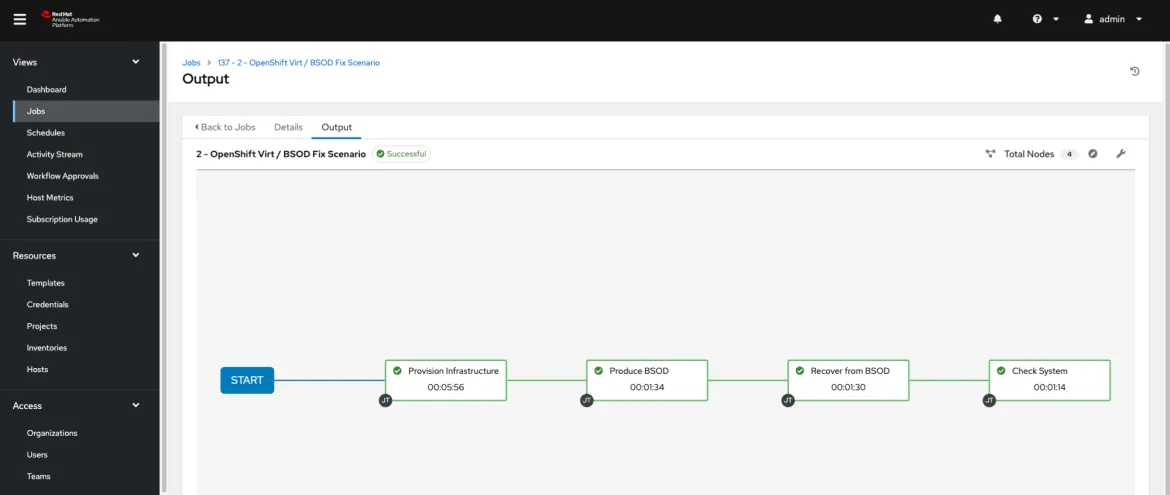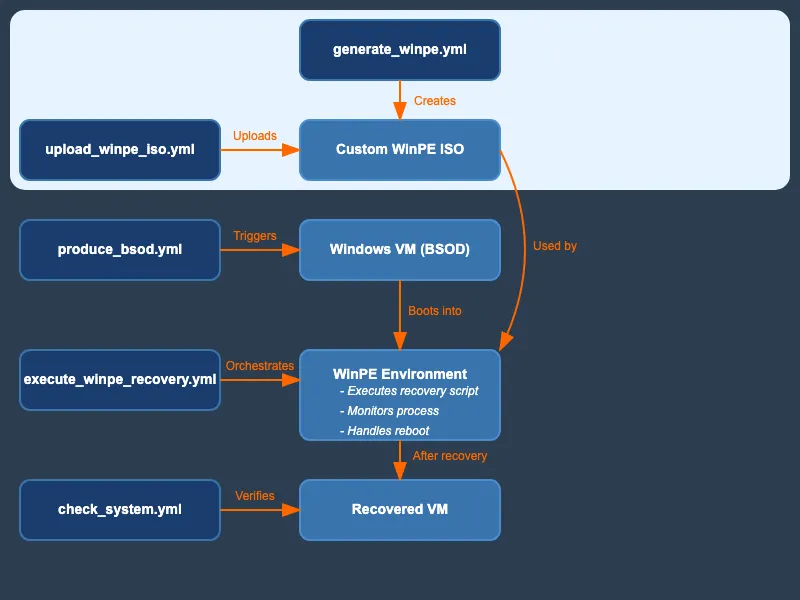In today's complex IT environments, system failures can occur unexpectedly, often due to failed updates or conflicts with third-party software. These issues can lead to significant downtime and productivity loss, especially in Windows environments where Blue Screen of Death (BSoD) scenarios can render systems inoperable. As IT professionals, we're constantly seeking flexible, scalable approaches to quickly recover from such failures across diverse infrastructure landscapes.
The Ansible Windows Automated System Recovery (including 0-Day BSoD) project offers an inspiring framework for addressing these challenges. This project demonstrates how Red Hat Ansible Automation Platform can be leveraged to create a streamlined approach for recovering Windows systems from critical failures, adaptable to various virtualization platforms.
The power of cross-platform automation
One of the key strengths highlighted by this project is the ability to manage the lifecycle of virtual machines across different environments. Whether your infrastructure is built on VMware vCenter or Red Hat OpenShift Virtualization, Ansible Automation Platform provides a unified interface for orchestrating recovery operations.
This cross-platform capability is crucial in today's hybrid cloud world, where organizations often operate across multiple virtualization technologies. With Ansible Automation Platform, you could:
- Generate custom Windows Preinstallation Environment (WinPE) ISOs tailored to your specific recovery needs
- Upload these ISOs to your chosen virtualization platform
- Boot affected VMs into the WinPE environment
- Execute recovery scripts to address the underlying issues
- Reboot systems and verify their health post-recovery
All of these steps can be automated, reducing the need for manual intervention and minimizing the potential for human error during critical recovery operations.
Seeing is believing: Automated recovery in action
To demonstrate the potential of this approach, here's a video showcasing an automated recovery process using Ansible Automation Platform (select the platform of your choice):
These demos illustrate how quickly and efficiently systems could be recovered using an automated approach, highlighting the possible time and resource savings for IT teams.
Real-world scenario: Recovering from a widespread BSoD incident
Imagine this scenario: Your organization has just pushed out a critical security update to thousands of Windows machines across multiple data centers. Despite following best practices such as canary deployments and phased rollouts, an unforeseen conflict with a third-party driver has caused a significant portion of these machines to experience BSoDs, rendering them inoperable.
This situation highlights several critical aspects of large-scale system management:
1. Importance of Staged Deployments: While canary deployments and phased rollouts can catch many issues early, some conflicts may only emerge at scale or in specific environments.
2. Need for Rapid Response: Even with careful planning, unforeseen issues can arise. The ability to quickly identify, respond to, and remediate problems is crucial.
3. Value of Automated Recovery: In large-scale incidents, manual recovery is often impractical. Automation becomes essential for reducing Mean Time To Recovery (MTTR) and minimizing business impact.
4. Balancing Security and Stability: Organizations must maintain up-to-date systems for security while ensuring operational stability. This balance requires robust tools and processes for both deployment and potential rollback scenarios.
Here's how a framework inspired by this project might be applied to address this situation:
- Rapid Response: Using Ansible Automation Platform, you quickly deploy a custom WinPE ISO containing scripts to remove the problematic update and roll back the driver.
- Multi-Platform Execution: The framework allows you to target both VMware vSphere VMs and those running on OpenShift Virtualization simultaneously.
- Automated Recovery: Ansible Automation Platform orchestrates the process of booting affected VMs into WinPE, executing the recovery scripts, and rebooting the systems.
- Scalable Solution: Whether you're dealing with 10 or 10,000 affected machines, the automation scales to meet your needs.
- Verification: Post-recovery, Ansible Automation Platform runs health checks on the recovered systems, ensuring they're back online and functioning correctly.
By leveraging an automated recovery framework, organizations can significantly reduce MTTR, minimizing downtime and its associated costs. This approach not only aids in crisis management, but also supports overall system resilience, allowing IT teams to maintain aggressive patching schedules with confidence in their ability to quickly recover if issues arise.
Moreover, the lessons learned from such incidents can be codified into the automation framework, continuously improving the organization's ability to respond to and prevent future issues. This iterative improvement process is key to maintaining robust, secure, and resilient IT systems in the face of ever-evolving challenges.
A flexible framework for various failure scenarios
While the project was initially inspired by a specific widespread system failure incident, its design allows for adaptation to various BSoD and system failure scenarios. The key to this flexibility lies in the separation of the recovery logic (embedded in the WinPE ISO) from the execution process.
This modular approach means that IT teams could:
- Customize recovery scripts for different types of system failures
- Embed these scripts into WinPE ISOs during the generation phase
- Use a consistent execution playbook across various failure types
This design provides a scalable and adaptable framework that can evolve with your organization's needs and the ever-changing landscape of potential system issues.
Understanding the automation workflow
To provide a clearer picture of how this recovery process works within Ansible Automation Platform, let's take a look at the visual workflow:

This workflow illustrates a potential step-by-step process that Ansible Automation Platform could orchestrate, from detecting a system failure to completing the recovery process. It showcases how automation might streamline complex operations and ensure consistency across recovery attempts.
Architecture overview
To give you a deeper understanding of how this solution framework is structured, let's examine the high-level architecture:

This diagram illustrates how Ansible Automation Platform might interact with various components of your infrastructure to execute a recovery process. It highlights the potential flexibility in working with different virtualization platforms and the ability to handle multiple recovery scenarios.
Multi-platform recovery: VMware vSphere and OpenShift Virtualization
One of the key strengths demonstrated by this project is its ability to operate across different virtualization environments. Specifically, this framework shows how automated recovery processes could be implemented for both VMware vSphere and OpenShift Virtualization platforms.
VMware vSphere integration
For organizations using VMware vSphere, this framework demonstrates how to seamlessly integrate with existing infrastructure. It shows how you could:
- Upload custom WinPE ISOs directly to your vSphere environment
- Manage VM states, including powering off affected systems and booting them into WinPE
- Execute recovery operations and verify system health post-recovery
OpenShift Virtualization support
If your organization leverages OpenShift Virtualization, this framework offers insights into comparable capabilities:
- Utilizing OpenShift's API to manage virtual machine lifecycles
- Supporting uploading and attaching recovery ISOs to affected VMs
- Executing recovery processes within the OpenShift ecosystem
By demonstrating support for both these platforms, this project provides inspiration for creating powerful tools for automated Windows recovery, regardless of your virtualization strategy.
Exploring the project
For those interested in diving deeper into the technical details, including code samples and configuration files, we encourage you to visit the project's GitHub repository:
Ansible Windows Automated System Recovery (including 0-Day BSoD) Project
This repository serves as a valuable resource and starting point for those looking to implement similar solutions in their own environments.
It's worth noting that while this project specifically demonstrates implementations for OpenShift Virtualization and VMware vSphere, Ansible Automation Platform's agnostic nature makes it highly adaptable. Whether your workloads run on Nutanix, Hyper-V, AWS EC2, Azure, Google Cloud Platform, or other environments including bare metal, Ansible Automation Platform offers robust integrations and modules to interact with these underlying infrastructures. This flexibility allows you to potentially adapt the concepts and workflows demonstrated in this project to a wide array of hosting platforms, making it a versatile starting point for automated recovery solutions across diverse IT landscapes.
Conclusion: Empowering IT teams with automation
The Ansible Windows Automated System Recovery project demonstrates the immense potential of automation in addressing complex IT challenges. By leveraging Ansible Automation Platform's capabilities, IT teams can explore ways to:
- Respond rapidly to system failures
- Ensure consistency in recovery processes
- Minimize downtime and its associated costs
- Free up valuable time for more strategic initiatives
As we continue to face new and evolving challenges in managing Windows environments, frameworks like this showcase how automation can be a powerful ally in maintaining system health and reliability.
We encourage you to explore this project and consider how its concepts might inspire solutions for the specific recovery needs in your organization.
Interested in exploring further? Visit our GitHub repository to review the code, star the project to stay updated, and consider how you might adapt or build upon this framework for your own environment. Your engagement and feedback are valuable in evolving these concepts to meet real-world needs.
To learn more about Ansible Automation Platform and how it can transform your IT operations, visit the Red Hat Ansible Automation Platform page.
Über den Autor
Orcun Atakan is a seasoned senior technology strategist with over 20 years of experience in architecting automation and cloud solutions for enterprise customers. Orcun joined Red Hat in 2016 where he has been leading the Global Automation practice, driving innovative solutions and advising on complex global private and hybrid cloud deployments. Orcun's diverse background includes roles in technical consulting, pre-sales, solution design, architecture, and technical enablement, with expertise in IT automation, hybrid cloud environments, DevOps, and business transformations for large clients.
Nach Thema durchsuchen
Automatisierung
Das Neueste zum Thema IT-Automatisierung für Technologien, Teams und Umgebungen
Künstliche Intelligenz
Erfahren Sie das Neueste von den Plattformen, die es Kunden ermöglichen, KI-Workloads beliebig auszuführen
Open Hybrid Cloud
Erfahren Sie, wie wir eine flexiblere Zukunft mit Hybrid Clouds schaffen.
Sicherheit
Erfahren Sie, wie wir Risiken in verschiedenen Umgebungen und Technologien reduzieren
Edge Computing
Erfahren Sie das Neueste von den Plattformen, die die Operations am Edge vereinfachen
Infrastruktur
Erfahren Sie das Neueste von der weltweit führenden Linux-Plattform für Unternehmen
Anwendungen
Entdecken Sie unsere Lösungen für komplexe Herausforderungen bei Anwendungen
Original Shows
Interessantes von den Experten, die die Technologien in Unternehmen mitgestalten
Produkte
- Red Hat Enterprise Linux
- Red Hat OpenShift
- Red Hat Ansible Automation Platform
- Cloud-Services
- Alle Produkte anzeigen
Tools
- Training & Zertifizierung
- Eigenes Konto
- Kundensupport
- Für Entwickler
- Partner finden
- Red Hat Ecosystem Catalog
- Mehrwert von Red Hat berechnen
- Dokumentation
Testen, kaufen und verkaufen
Kommunizieren
Über Red Hat
Als weltweit größter Anbieter von Open-Source-Software-Lösungen für Unternehmen stellen wir Linux-, Cloud-, Container- und Kubernetes-Technologien bereit. Wir bieten robuste Lösungen, die es Unternehmen erleichtern, plattform- und umgebungsübergreifend zu arbeiten – vom Rechenzentrum bis zum Netzwerkrand.
Wählen Sie eine Sprache
Red Hat legal and privacy links
- Über Red Hat
- Jobs bei Red Hat
- Veranstaltungen
- Standorte
- Red Hat kontaktieren
- Red Hat Blog
- Diversität, Gleichberechtigung und Inklusion
- Cool Stuff Store
- Red Hat Summit

